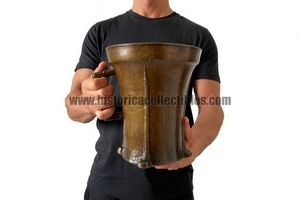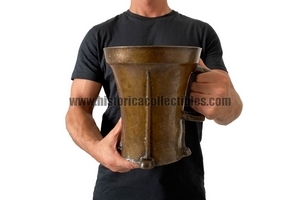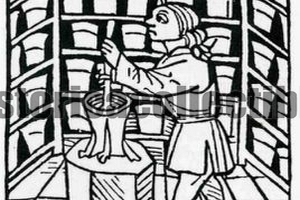German Gothic Bronze Mortar, circa 1400/1420
GROSSER GOTISCHER BRONZEMÖRSER 1400/1420. Bronze mortar of typical German-Gothic style, probably made in the territories of Nuremberg or Regensburg between 1400 and 1420; its elongated truncated cone shape shows massive walls and a wide single-order high-end mouth, the large and robust inclined handle for gripping is in a single fusion with the structure.
On the flared part of its surface, four perpendicular ribs develop, at an equal distance from each other, designed to strengthen it. As they descend just below the band of the mouth, they gradually widen until they join the massive hemispherical feet protruding from the base which provide the artefact greater support surface and stability.
Furthermore, this mortar is undeniably linked to an austere stylistic era, still centered on a rigorous linearity, like its specific details which avoid any artifice and ornament, nothing superfluous appears in fact, their shapes, determined by essentiality, characterize it from most of the specimens that appeared decades later on which the first decorative forms were outlined.
Subsequently, with the spread of the new "Gothic-Renaissance" artistic period, the conformations of these artefacts underwent substantial changes, also due to the widespread use of ornamental elements that extend in relief on their surface, almost always formed by the repetition of figures, friezes , inscriptions or coats of arms, even if often rudely executed.
Therefore, with thoughtful reason of validity, noted on the basis of the explicit gaps that undoubtedly exist between these artefacts, this mortar is believed to have been made in the full "High German Gothic" period between 1400 and 1420.
This particular type of bronze mortar, made with the lost wax casting technique, was intended for pharmaceutical use.
Inside them, in fact, various raw materials were, using bronze pestles, chopped and ground until they were reduced to powder and could therefore be used, alone or mixed with others, for pharmacological purposes.
The state of conservation is excellent, its simple and austere shape is attractive, veiled by a wonderful brown patina.
Its height is 22 cm, the diameter at the mouth is 19 cm.
Reference Bibliography:
Giorgio Lise, “Antichi Mortai di farmacia”, 1975 Silvana editoriale d’arte, Milano.
Ulrich Middeldorf, “Fifty Mortars 15th -18th Century”, 1981 Firenze.



